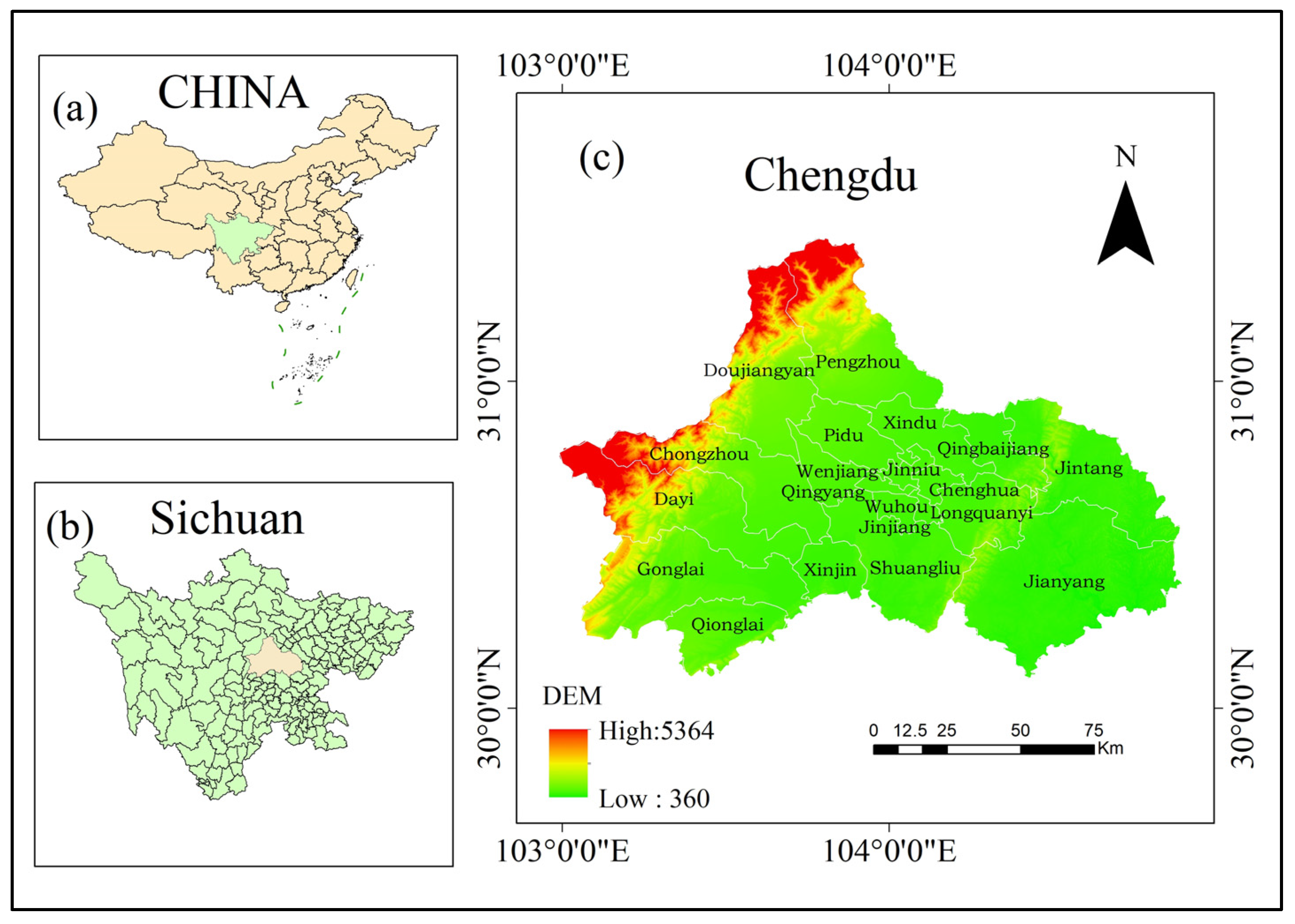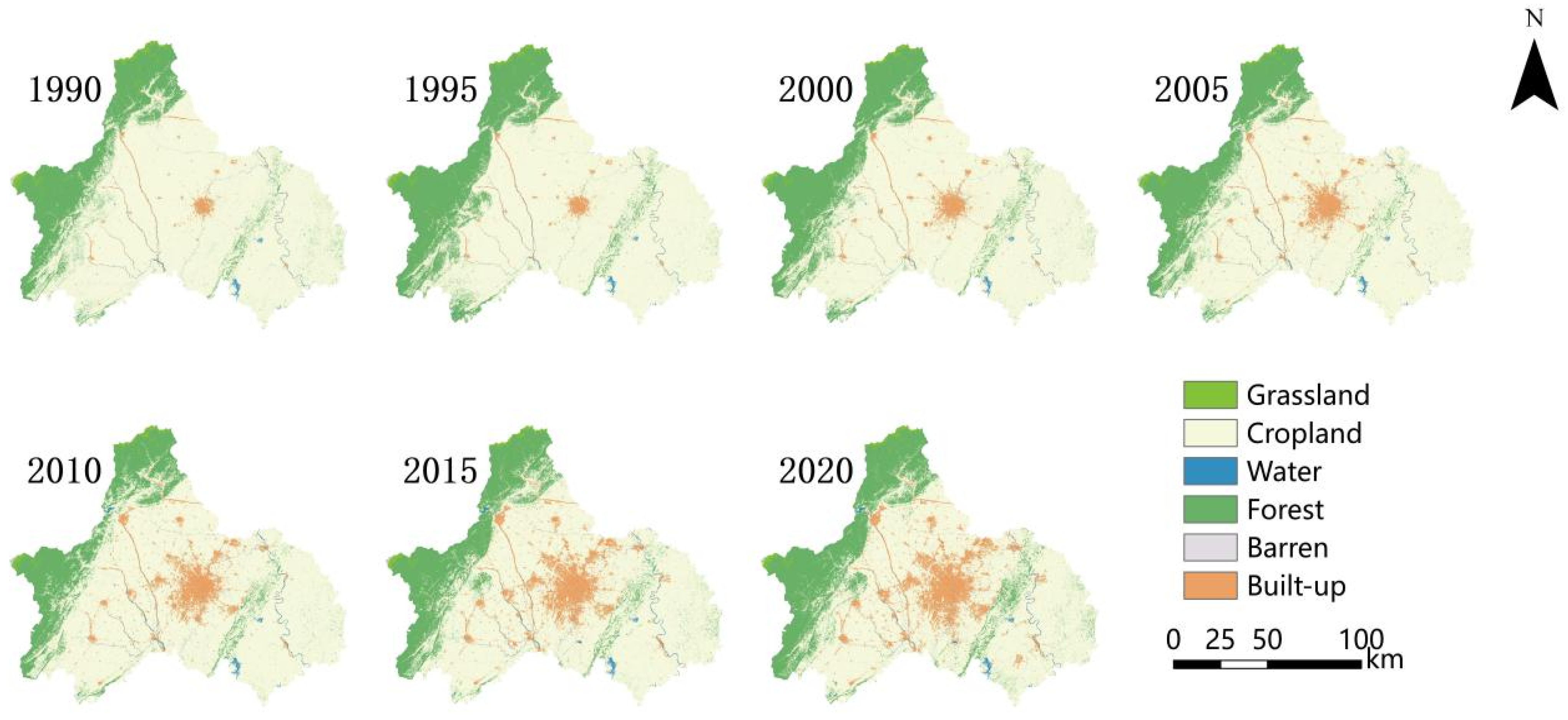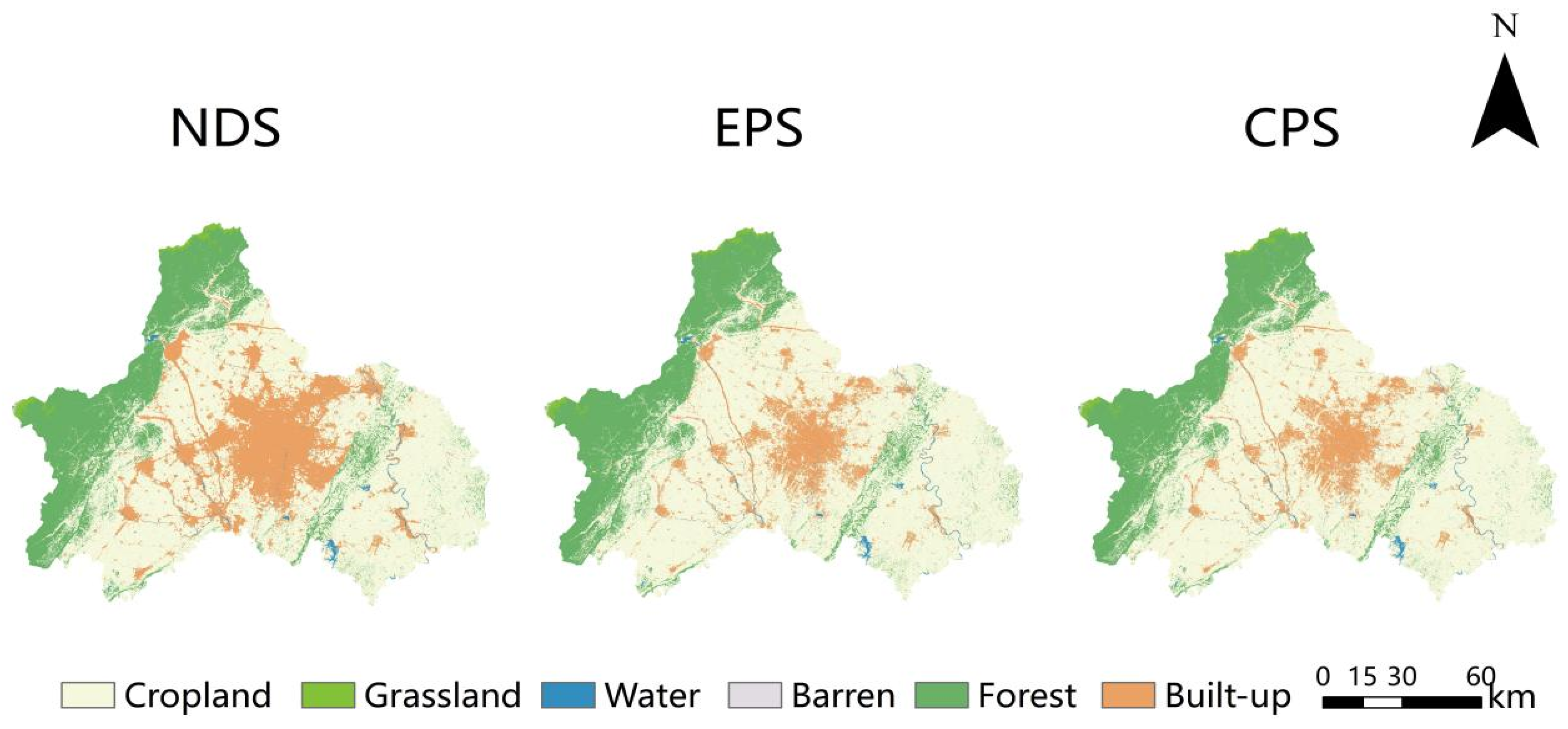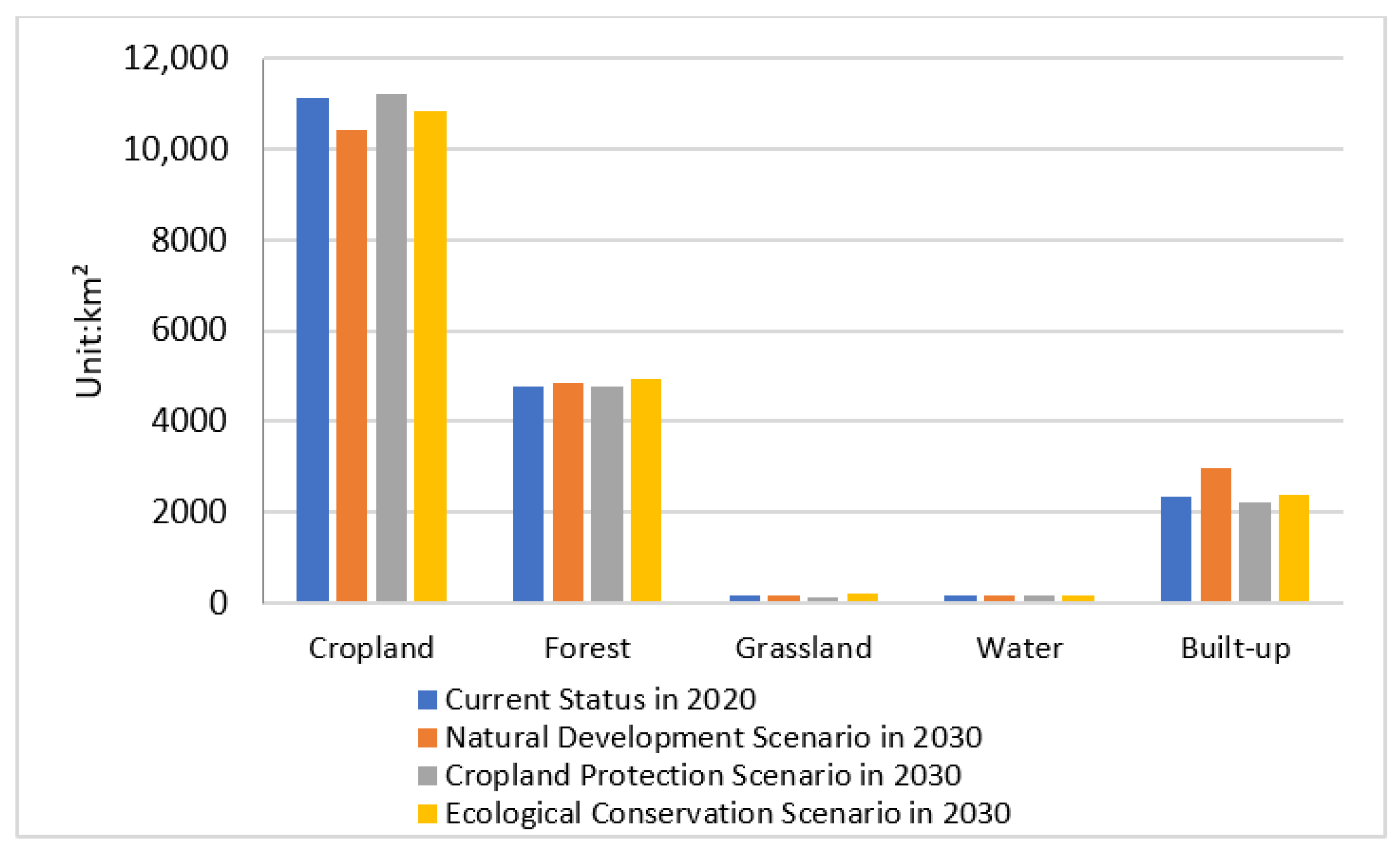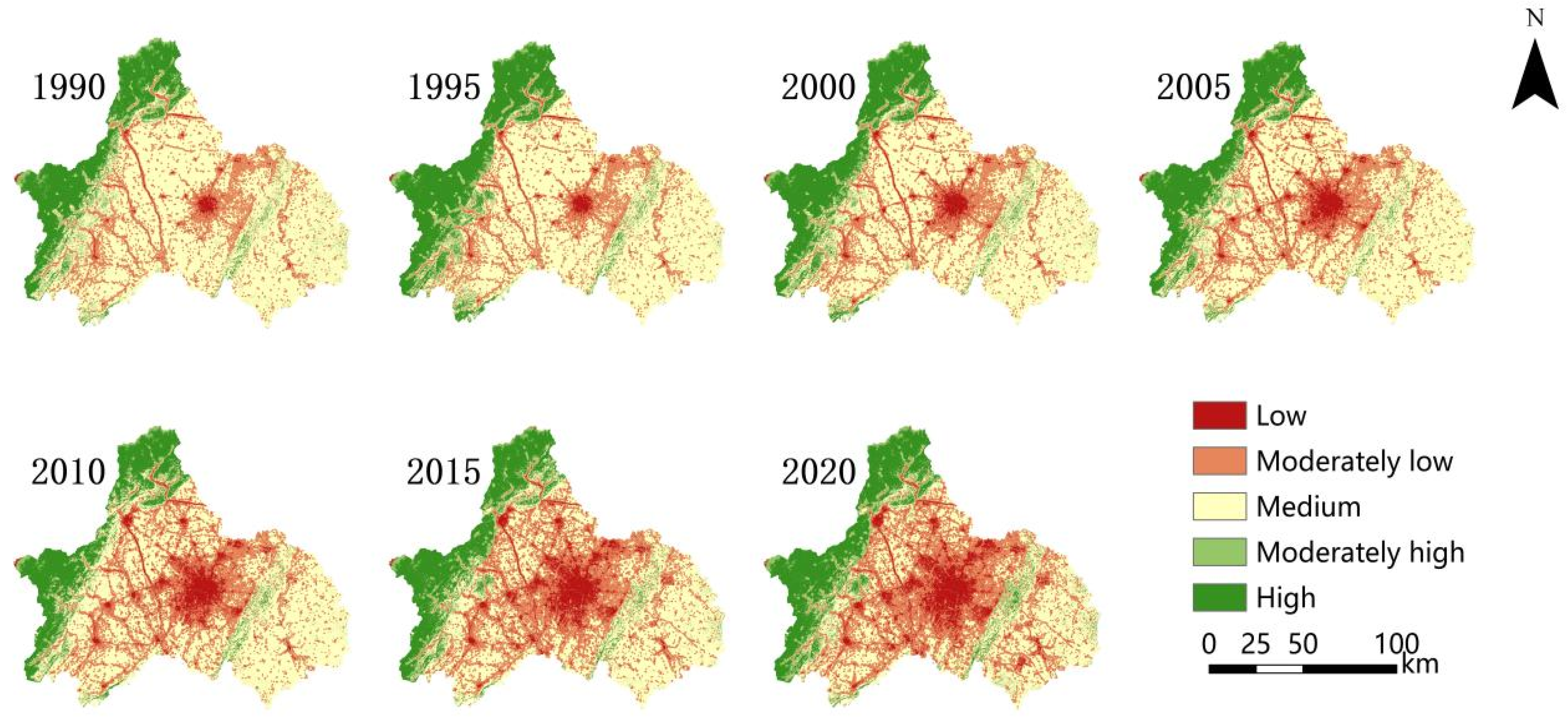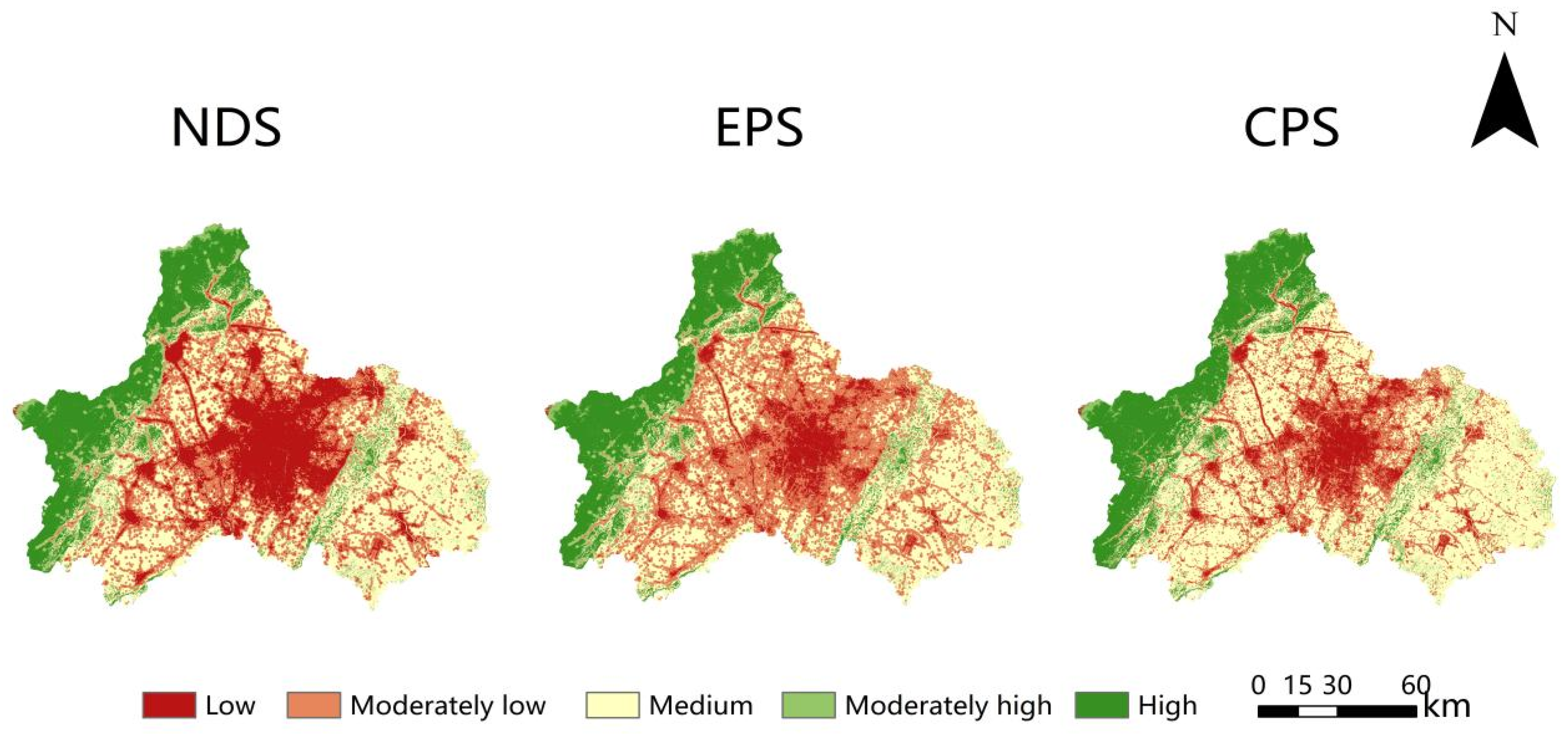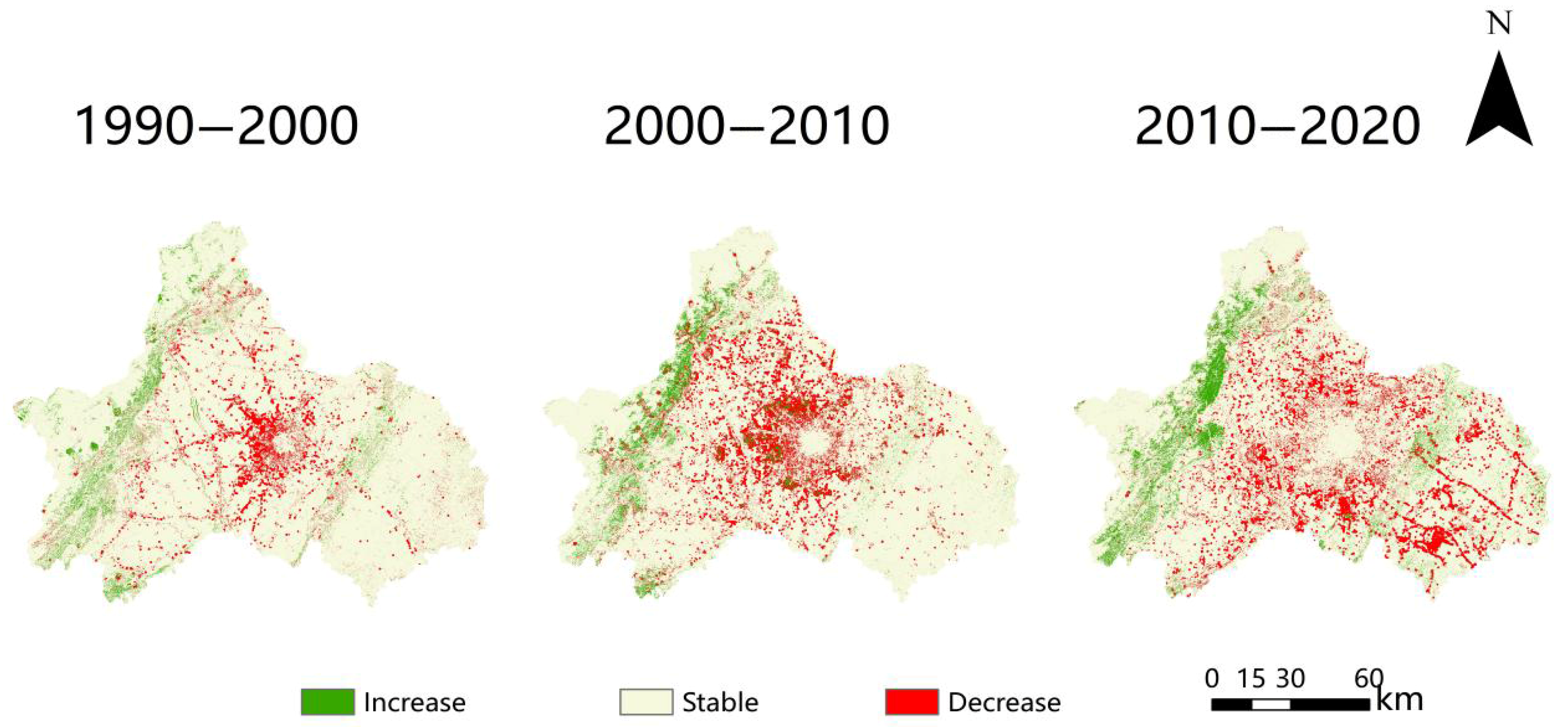3.1. Land-Use Transfer Matrix Analysis
According to
Table 9, Chengdu’s cropland area underwent significant changes over the past 30 years, with frequent conversions between land-use types, driven by economic development and policy adjustments. Notably, forest and water contributed the largest inflows into cropland, at 305.78 km
2 and 54.23 km
2, respectively. Conversely, cropland losses primarily occurred through conversions to built-up area (1442.51 km
2) and forest (765.56 km
2).
From 1990 to 2000 (
Table 10), cropland’s total outflow reached 775.09 km
2, with 64.06% converted to forest (496.54 km
2) and the remainder mainly to built-up area (262.35 km
2) and water (13.21 km
2). This trend aligns with China’s deepened reform and opening-up in the 1990s and the launch of the Western Development Strategy. As a pilot city for inland opening, Chengdu experienced accelerated industrialization and infrastructure development, leading to extensive cropland conversion. Inflows into forest increased by 556.81 km
2, reflecting the initial impact of the Grain for Green Policy (e.g., the Regulations on Returning Farmland to Forest in 1999), although policy effects remained partial, with ecological land growth lagging behind urban expansion.
Between 2000 and 2010 (
Table 11), cropland’s outflow further increased to 797.57 km
2, while the inflow increased significantly (871.11 km
2), primarily from forest conversion. The Policy of Returning Farmland to Forest showed significant effectiveness. The built-up inflow reached 602.64 km
2, with a slower growth rate than the previous decade, indicating stricter land approval after the 2004 revision of the Land Administration Law. The forest inflow rose to 141.09 km
2, directly linked to the 2003 Natural Forest Protection Program and post-2008 Wenchuan Earthquake ecological restoration projects. Reduced inflows into grassland (18.51 km
2) and water (66.02 km
2) reflected a shift from single-focused farmland-to-forest policies to comprehensive ecological governance, although land-use inefficiencies issues persisted locally.
From 2010 to 2020 (
Table 12), cropland’s outflow surged to 1631.47 km
2, with only 173.28 km
2 inflow, exacerbating the net loss. The built-up inflow decreased to 598.45 km
2, with further slowed growth. The forest inflow rose sharply to 1018.56 km
2, consistent with the national strategy of Ecological Civilization Construction (2012) and Chengdu’s “Park City” initiative (proposed in 2018). The water body inflow increased to 29.32 km
2, likely associated with sponge city construction and river/lake ecological restoration projects. The barren outflow dropped to 3.75 km
2, indicating initial success of land reclamation and intensive use policies.
3.2. Spatiotemporal Analysis of Land Use in Chengdu
Based on the current land-use map of Chengdu (
Figure 2), from 1990 to 2020, the built-up area expanded continuously, increasing from approximately 271.32 km
2 in 1990 to 1460.79 km
2 in 2020, with an average annual growth rate of 6.4%. It is primarily concentrated in central Chengdu, including the Jinniu, Wuhou, Jinjiang, Chenghua, and Qingyang districts, forming large, densely packed clusters. Cropland decreased significantly, with a net loss of 2268.81 km
2, mainly in sub-urban plains areas such as Longquanyi and Shuangliu. Forest showed a dynamic change pattern of increase–decrease–increase over 30 years. From 1990 to 2000, benefiting from the construction of the western Sichuan shelterbelt system during the Eighth Five-Year Plan, the forest area increased by approximately 348.81 km
2. Between 2000 and 2010, due to the national policy of abolishing agricultural tax, which boosted farmers’ enthusiasm for opening up wasteland for cropland, the forest area decreased by 718.61 km
2 during this period. After 2010, driven by policy interventions, the forestland area recovered to 3746.53 km
2 by 2020, concentrated in the western and northern regions (Pengzhou, Dujiangyan, Dayi, and Chongzhou), with scattered patches in Qionglai and Longquanyi. Water and grassland showed fluctuating changes: the water area increased slightly due to water conservancy projects and sponge city construction, extending along the Dujiangyan irrigation system and forming important networks via the Min and Tuojiang rivers through the urban area; grassland recovered locally due to farmland-to-grassland and ecological restoration policies, mainly in Dayi, Pengzhou, and Dujiangyan. Barren land gradually shrank from 7.37 km
2 in 1990 to 4.89 km
2 in 2020, reflecting the effectiveness of land reclamation and intensive use policies.
(1) 1990–2000: Initial Urbanization and Land-Use Transformation Stage
In 1990, Chengdu had limited built-up area, concentrated in the city center, with a narrow urban radiation range. Cropland dominated the surrounding areas, forming the primary land-use type. Grassland and forest were concentrated in the north, maintaining a natural ecological pattern, while water was sporadically distributed and barren land was minimal. By 2000, the built-up area expanded noticeably, indicating initial urbanization. Cropland decreased due to urban expansion, marking the beginning of non-agricultural conversion, although the landscape remained an agricultural–urban mix, with natural ecological lands (grassland, forest) largely intact. Water and barren land changed modestly.
(2) 2000–2010: Rapid Urbanization Driven by Economic Growth
After 2000, Chengdu’s economy accelerated, leading to a surge in built-up area by 2010, which spread outward and expanded the urban space significantly. Cropland continued to decline, as it was heavily converted to urban use, with peri-urban farmland rapidly transforming into built-up areas. Grassland and forest retained their scale in the north but faced indirect impacts from urban expansion at their margins. Water underwent local adjustments due to urban construction, and barren land further decreased, with land use tilting toward intensive urban development. This period was critical for urbanization reshaping the land-use structure, highlighting the primacy of urban construction needs in human–land relationships.
(3) 2010–2020: Deepened Urbanization and Land-Use Optimization
By 2020, the built-up area continued to expand, but at a slowing rate, as urban development shifted from “incremental expansion” to “stock optimization.” The pressure on cropland protection persisted, with surrounding farmland experiencing fragmented loss. Grasslands and forests in the northern region remained critical ecological barriers, maintaining relatively stable areas that reflected improved awareness of ecological conservation. Water was likely to gain increased attention in urban planning, serving dual functions of ecology and landscape. Barren land had nearly vanished, indicating more efficient utilization of land resources. At this stage, land use prioritized urban–rural coordination: while accommodating urban development, efforts were made to balance ecological protection—for example, the preservation of forests and grasslands provides an ecological foundation for sustainable urban growth.
According to the scenario simulation results in
Figure 3 and
Figure 4, the cropland trends vary significantly across scenarios: (1) Natural Development Scenario: Cropland decreases sharply by 712.37 km
2. (2) Ecological Priority Scenario: Cropland remains essentially stable, with minimal change. (3) Cropland Protection Scenario: Cropland increases by 106.62 km
2. Grassland, water, and barren land show limited fluctuations, with no drastic changes. Built-up area in the natural development scenario expands radially from settlements, increasing by 637.27 km
2. Overall, Chengdu’s land-use patterns exhibit distinct dynamics under different scenarios: the cropland protection and ecological priority policies have significant positive effects on farmland conservation, while natural urban expansion drives rapid built-up growth.
3.3. Analysis of Regional Habitat Quality Changes in Chengdu
Using the regional habitat quality module in InVEST and Chengdu’s 1990–2020 land-use data, we classified regional habitat quality into five classes using the equal-interval method: low (0–0.2), moderately low (0.2–0.4), medium (0.4–0.6), moderately high (0.6–0.8), and high (0.8–1). As shown in
Figure 5, the spatial pattern of regional habitat quality in Chengdu exhibits a pronounced west-to-east gradient of “superior in the west, inferior in the east,” closely linked to the coupling of regional topography, land-use types, and human activity intensity. The western Longmen Mountain Range and hilly areas (Chongzhou, Dayi, Qionglai, Pengzhou, Dujiangyan)—serving as ecological barriers for the Chengdu Plain—are dominated by forest (38.7%) and grassland (12.5%), forming complex mountain ecosystems with high landscape connectivity and biodiversity support. For example, the Longxi–Hongkou Nature Reserve in Dujiangyan, a core giant panda habitat, has 23.6% of its area in high-quality habitat (0.8–1), demonstrating the direct role of natural vegetation in sustaining regional habitat quality. In stark contrast, the central–eastern plains (urban districts like Jinniu, Qingyang, Wuhou, and Jinjiang) have a built-up coverage of 65.2%, with the regional habitat quality generally below 0.4, confirming the stress of artificial landscapes on natural habitats.
From 1990 to 2020, the mean regional habitat quality indices were 0.5242, 0.5406, 0.5215, 0.5044, 0.4778, 0.4720, and 0.4708, showing an overall downward trend—a result of land-use transformation and ecosystem service trade-offs.
Table 13 shows the following:
1990–1995 Brief Improvement Period: The index rose from 0.5242 to 0.5406, driven by the construction of the western Sichuan shelter forest system during the “Eighth Five-Year Plan,” which increased the forest area by 348.81 km2. Notably, the initial restoration of the Longquan Mountain Ecological Belt led to a 29.3% increase in moderately high-quality habitats (0.6–0.8), illustrating that regional ecological projects can improve local regional habitat quality in the short term.
1995–2010 Rapid Degradation Period: With the Western Development Strategy, Chengdu’s GDP grew at 15.3% annually, and its built-up area expanded by 53.43 km2/year, primarily converting cropland (68%) and forest (22%). The Tianfu New Area exemplifies this: between 2005 and 2010, the built-up area there increased by 300%, coinciding with a 37% drop in the regional habitat quality index.
2010–2020 Slowing Adjustment Period: Under the “Ecological City” strategy, Chengdu delineated 13 ecological redlines, increased green coverage in built-up areas from 38% to 45%, and restored 11,600 hectares of wetlands in the urban ring ecological zone, significantly improving local habitats.
Under the natural development, ecological priority, and cropland protection scenarios, the mean regional habitat quality indices for 2030 are 0.4442, 0.4990, and 0.4712, respectively (
Figure 6,
Table 14). The ecological priority scenario yields the highest quality, with increases compared to 2020 driven by reductions in moderately high-quality habitats (−347.73 km
2) and increases in high-quality habitats (+382.84 km
2). Continuous improvements occur in the Xiling Snow Mountain–Qingcheng Mountain Ecological Belt and Longquan Mountain Forest Belt, forming a “ecological core” in western Chengdu that diffuses eastward via river corridors (Min and Tuojiang rivers), increasing moderately high-quality habitats (0.6–0.8) in the central city by 12% and alleviating the urban heat island effect.
In the natural development scenario, the lowest mean index is driven by a 1404.31 km2 increase in low-quality habitats, which expand “branch-like” along metro lines and highways (e.g., within 5 km of the Chengdu–Dujiangyan and Chengdu–Wenjiang–Qionglai routes, low-quality habitats grew by 45% compared to 2020), forming typical “transport corridor stress zones.”
The cropland protection scenario shows a slight index increase, with reductions in moderately low-quality habitats (−2024.52 km2) and increases in medium-quality habitats (+2022.87 km2). The regional habitat quality changes minimally in the core urban area inside the ring expressway, but medium-quality habitats rise significantly in peripheral cropland zones (e.g., Dayi Plain, Xinjin farmland), forming a three-tier gradient of “urban–farmland–mountain” habitats—evidence of positive agricultural ecosystem intervention through cropland protection policies.
3.4. Response of Regional Habitat Quality to Land-Use Changes in Chengdu
As shown in
Figure 7, from 1990 to 2000, land use in Chengdu was dominated by built-up expansion in the central urban area. Core districts like Jinniu and Wuhou saw significant regional habitat quality declines due to increased industrial and residential land demands. Conversely, western undeveloped areas (e.g., southern Pujiang County) experienced localized improvements from natural expansion of forest and grassland. Between 2000 and 2010, driven by the Western Development Strategy and agricultural tax relief, Chengdu’s economy grew at 12.4% annually, with urbanization rates rising from 34.8% to 52.6%. This period witnessed city-wide development, with 68.7% of the area showing declining regional habitat quality. From 2010 to 2020, following the implementation of the Chengdu Ecological Civilization Construction Plan, land-use strategies shifted to “western conservation–eastern intensification”: western regions like Dujiangyan and Pengzhou added 879.71 km
2 of forest through park city initiatives and farmland-to-forest projects, while eastern Jianyang saw localized habitat degradation due to Tianfu International Airport’s construction.
Table 15 shows that positive contribution rates indicate land-use changes detrimental to regional habitat quality, while negative rates signal beneficial effects, revealing the ecological impact mechanisms of different land conversions:
(1) Positive Ecological Effects:
Cropland-to-forest conversion (contribution rate −7.67%) was the most significant ecological gain factor, directly linked to three rounds of the “Grain for Green and Grassland Program” (1999–2003 pilot, 2007 consolidation, and 2014 expansion). Although barren-to-forest conversion had a small absolute contribution (−0.0041%), it effectively curbed desertification in ecologically fragile areas like the Longmen Mountain Fault Zone, providing marginal ecological benefits.
(2) Negative Ecological Effects:
Cropland loss itself (18.68%) and conversion to built-up area (12.59%) were the primary drivers of habitat degradation. The former reflects trade-offs between food security and ecological protection: a net loss of 1458.18 km2 of cropland from 2010 to 2020, with 40% converted to construction, caused annual losses of CNY 1.27 billion in farmland ecosystem service values (carbon sequestration, biological control, etc.). The high contribution rate of cropland-to-built-up conversion (12.59%) highlights the structural damage of urbanization to ecosystems.
(3) Marginal Effect Disparities in Land Conversions:
Grassland–cropland conversions exhibited “asymmetric ecological impacts”: conversion of cropland to grassland contributed only 0.0235% to degradation, while conversion of grassland to cropland brought a 0.0059% improvement. This reflects that grasslands in the Chengdu Plain are mostly low-coverage secondary meadows with lower ecological value than cultivated farmland. The “bidirectional negative effects” of water body conversions are concerning—both water body–built-up (0.1945%) and water body–cropland (0.1578%) conversions led to habitat degradation, indicating the irreversibility of water ecosystem damage and the need to strengthen protection redlines for rivers like the Min and Tuojiang.
